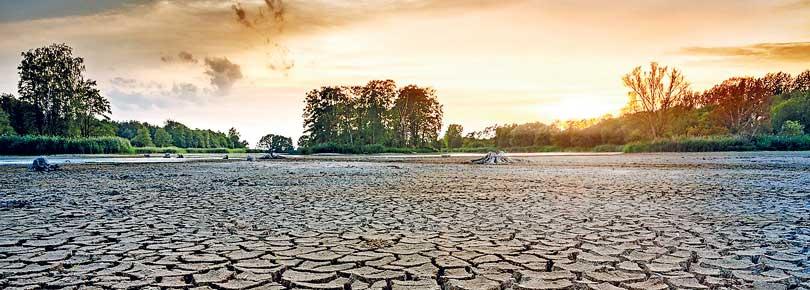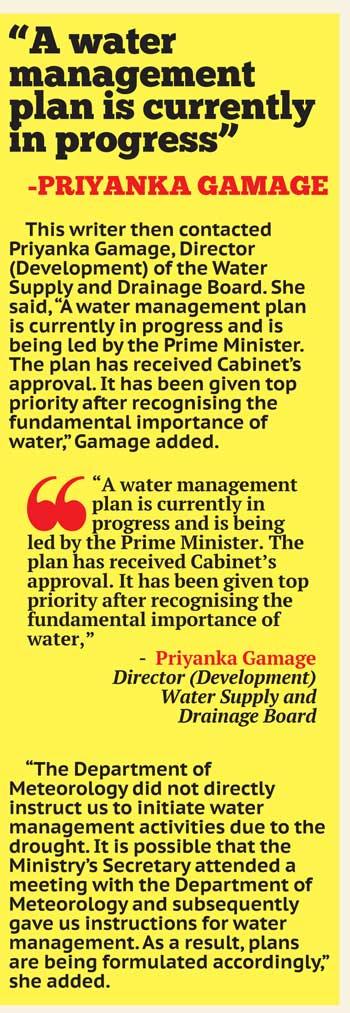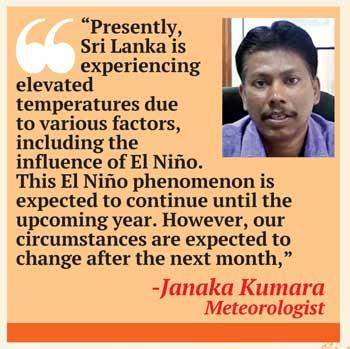Reply To:
Name - Reply Comment
Last Updated : 2024-05-08 06:15:00

 El Niño occurs approximately once every 7-10 years. The El Niño effect takes place globally due to shifts in equatorial current patterns. In this case, sea winds fail to cool the ocean’s surface, leading to warmer seawater. Consequently, the surface temperature of the earth experiences an increase. Many countries globally detect such conditions. Presently, Sri Lanka has experienced an El Niño effect. Despite being aware of this situation, Sri Lanka took no corresponding measures and the public was uninformed. This has led to a severe crisis in the country due to dry weather conditions. However, strangely, despite the present El Niño effect being present there are some areas in Sri Lanka that are experiencing heavy rains.
El Niño occurs approximately once every 7-10 years. The El Niño effect takes place globally due to shifts in equatorial current patterns. In this case, sea winds fail to cool the ocean’s surface, leading to warmer seawater. Consequently, the surface temperature of the earth experiences an increase. Many countries globally detect such conditions. Presently, Sri Lanka has experienced an El Niño effect. Despite being aware of this situation, Sri Lanka took no corresponding measures and the public was uninformed. This has led to a severe crisis in the country due to dry weather conditions. However, strangely, despite the present El Niño effect being present there are some areas in Sri Lanka that are experiencing heavy rains.
 By March, this situation was clearly understood. The Department of Meteorology informed government institutions including the Ministry of Irrigation, the Electricity Board, the Ministry of Agriculture and the Water and Drainage Board about the situation. However, former Agriculture Director K.B. Gunaratne said that government officials were unable to effectively manage the existing water resources with proper measures. “Drawing from practical knowledge, farmers knew that rainfall is typically lower during the months of April and May, with the onset of the southwest monsoon. In a country facing an economic crisis, officials should possess solid knowledge of water management to address the nation’s food requirements. The Department of Meteorology informed relevant government officials about this drought situation in February and March,” said Gunaratne. He questioned about the measures taken by the Ministry of Agriculture, the Ministry of Mahaweli, the Ministry of Water Supply, and the Ceylon Electricity Board regarding this issue.
By March, this situation was clearly understood. The Department of Meteorology informed government institutions including the Ministry of Irrigation, the Electricity Board, the Ministry of Agriculture and the Water and Drainage Board about the situation. However, former Agriculture Director K.B. Gunaratne said that government officials were unable to effectively manage the existing water resources with proper measures. “Drawing from practical knowledge, farmers knew that rainfall is typically lower during the months of April and May, with the onset of the southwest monsoon. In a country facing an economic crisis, officials should possess solid knowledge of water management to address the nation’s food requirements. The Department of Meteorology informed relevant government officials about this drought situation in February and March,” said Gunaratne. He questioned about the measures taken by the Ministry of Agriculture, the Ministry of Mahaweli, the Ministry of Water Supply, and the Ceylon Electricity Board regarding this issue.
Back in 2016-2017, Sri Lanka encountered an El Niño situation; however, it didn’t lead to the current crisis. Gunaratne added that it was because of the timely and essential actions taken by responsible authorities that Sri Lanka was able to face this situation. “This time, however, no official undertook the necessary measures to confront the severe drought. Had the required actions been taken, it would have been possible to cultivate short-term crops and minimise the impacts of the drought,” Gunaratne added.
“Usually, the water management committee meets before a season commences. All officials related to the agriculture sector participate in this; including Agriculture, Irrigation, Agricultural Services, Export Agriculture, Mahaweli officials, as well as ministerial officials. The committee decides the amount of water that can be released for the season; the start date of the season, the date of water release, and the crops to be grown. In this case, if the Meteorological Department had informed these officials about the upcoming dry season by March, one should find out who made the wrong decisions,”
Gunaratne further added. He pointed out that if the correct decision had been made, there would have been no need to pay huge compensation in the form of crop damage.
Fingers pointed at Agriculture Minister
But this year, this meeting was held in July and it did not fall within the Yala or Maha season. “Normally, the seasonal meeting should take place in March; before the season. There has not been any formal seasonal meeting in Sri Lanka since 2016-2017. The two-day meeting is chaired by the Minister of Agriculture. Therefore, the Minister of Agriculture should take direct responsibility instead of creating a media show claiming that his fields were also destroyed,” affirmed Gunaratne. Additionally, Gunaratne said that the Secretary of the Ministry of Agriculture should also be directly responsible for the crop damage.
Even though this year’s drought may lead to crop damage, there will be no shortage of rice in the country. “This is because the rice wholesalers have sufficient stock. Furthermore, 60 percent of the Yala season’s crops have already been harvested, and the crop damage is estimated to be around 15 percent. Therefore, despite rice not being in short supply, a small quantity will still need to be imported,” Gunaratne pointed out.
 During the Yala Season, an average of 500,000 acres is typically cultivated. This year, an area of 484,437 acres has been cultivated, which accounts for 89 percent of the target area. “Accordingly, the harvest is projected to yield 1.81 million metric tons. Even if the yield is less than 15 percent, the remaining amount should still be sufficient to meet the country’s rice requirements. Currently, large-scale paddy mill owners have reserves of paddy from the previous season. Farmers also have stocks of rice due to low paddy prices. However, some may attempt to artificially increase the price of rice by creating a shortage,” he added. Gunaratne also said that the government should also be attentive regarding this issue.
During the Yala Season, an average of 500,000 acres is typically cultivated. This year, an area of 484,437 acres has been cultivated, which accounts for 89 percent of the target area. “Accordingly, the harvest is projected to yield 1.81 million metric tons. Even if the yield is less than 15 percent, the remaining amount should still be sufficient to meet the country’s rice requirements. Currently, large-scale paddy mill owners have reserves of paddy from the previous season. Farmers also have stocks of rice due to low paddy prices. However, some may attempt to artificially increase the price of rice by creating a shortage,” he added. Gunaratne also said that the government should also be attentive regarding this issue.
The 2023/2024 Maha season is set to begin next month. According to the Meteorological Department, heavy rainfall is expected in October and November. Consequently, in case of insufficient rain, preparations must be made prior to the essential activities for the season. This includes providing paddy seeds, fertilizers and high-quality pesticides. “However, up to this point, farmers have not received any substantial assistance from the government. Hence, it’s essential to overcome these challenges to ensure a successful season. In the event of inadequate water supply for the Maha season, short-term rice varieties should be cultivated or alternative field crops like green beans, cowpeas and millets can be grown,” he pointed out. Gunaratne also said that without a water management plan, even the Maha season could end up being a failure.
 This year, there are differing opinions regarding compensation for crop damage. “A decision needs to be made whether compensation should be based on the expenses incurred per hectare or the gross yield obtained from one hectare. The cost of cultivating one hectare is approximately 300,000 rupees, with slight variations across regions. The approximate paddy yield ranges from 3000 to 5000 kg per hectare. Taking the country’s average yield as 3500 kg per hectare, even if a fixed rate of 100 rupees per kilo is considered, the compensation should be around 300,000 to 350,000 rupees per hectare. According to the current data, 18,500 hectares or 46,000 acres have been affected by drought. Therefore, the government would have to pay a total of 5,550,000,000 rupees even if they opt for a 300,000 rupee compensation per hectare. It is hard to believe that the government would agree to such a compensation amount, said Gunaratne. He underscored that this situation shows the gravity of the crisis caused by the negligence on the part of the officials in the face of a severe calamity.
This year, there are differing opinions regarding compensation for crop damage. “A decision needs to be made whether compensation should be based on the expenses incurred per hectare or the gross yield obtained from one hectare. The cost of cultivating one hectare is approximately 300,000 rupees, with slight variations across regions. The approximate paddy yield ranges from 3000 to 5000 kg per hectare. Taking the country’s average yield as 3500 kg per hectare, even if a fixed rate of 100 rupees per kilo is considered, the compensation should be around 300,000 to 350,000 rupees per hectare. According to the current data, 18,500 hectares or 46,000 acres have been affected by drought. Therefore, the government would have to pay a total of 5,550,000,000 rupees even if they opt for a 300,000 rupee compensation per hectare. It is hard to believe that the government would agree to such a compensation amount, said Gunaratne. He underscored that this situation shows the gravity of the crisis caused by the negligence on the part of the officials in the face of a severe calamity.
Certain government parties might attempt to exploit the drought as an excuse to import rice without hesitation; targeting commissions. India has prohibited rice exports. “A 40 percent tax has been levied on onion. In this context, it is crucial for the government to take measures to safeguard local rice stocks. In 2022 alone 783,000 metric tons of rice was imported, incurring an expenditure of 87,500 million rupees. This situation arises from the absence of a proper agricultural policy within the country, which has led the nation into a severe predicament. By April 2023, the country’s inflation had surged to 33.3 percent, with food inflation at 30.6 percent. Sri Lanka’s GDP contracted by 4.6 percent in 2022 and by 7.8 percent in 2023. Consequently, the challenges ahead are not easy,” he added. Gunaratne also said that the authorities should be attentive to these concerns.
“We shared information about this dry weather condition in February”
-Janaka Kumara (Meteorologist)
The Daily Mirror reached out to the Department of Meteorology. Meteorologist Janaka Kumara provided the following explanation: “Presently, Sri Lanka is experiencing elevated temperatures due to various factors, including the influence of El Niño. This El Niño phenomenon is expected to continue until the upcoming year. However, our circumstances are expected to change after the next month. At present, districts such as Polonnaruwa, Trincomalee, and Vavuniya experience high temperatures. In March, we informed the relevant authorities about the existing drought situation. When a monsoon season approaches, we hold discussions. Our role is to forecast the forthcoming weather conditions across the country. We ask all relevant government bodies to be present during these discussions. We provide them with insights into the future weather outlook. Subsequent actions are to be taken by the respective government institutions based on the decisions made in these sessions. We cannot do anything beyond that. We shared information about this dry weather condition in February,” warned Kumara.
This newspaper also reached out to the Mahaweli Authority. A spokesperson said that the Meteorological Department had informed about the dry weather conditions back in February. “Various government institutions such as Mahaweli and the Agriculture Department were informed about this situation during the water management committee. Despite that effective water management decisions weren’t taken. The engineers of the Mahaweli Authority conveyed information to the Ministry of Agriculture regarding the intended areas for paddy and other additional crops. However, the intended plan was not put into action, resulting in cultivation not aligning with the proposed approach. The situation has led to a level of devastation exceeding the crop damage,” he explained. \
This newspaper then attempted to contact the Secretary of the Ministry of Agriculture Gunadasa Samarasinghe. He was engaged in a meeting at the time this newspaper spoke to him. A spokesperson of the institute asked us to make contact again and a follow-up call was made, but our efforts proved futile. Even at the writing of writing there was no response from the Secretary of the Ministry of Agriculture.
This newspaper attempted to contact the General Manager of the Ceylon Electricity Board. However, an employee said that the General Manager was unavailable to make a comment.
Weather God Tuesday, 05 September 2023 11:55 AM
A FORTNIGHT BACK WHEN THE COUNTRY WAS EXPERIENCING SEVERE DROUGHT REPORTS SAID THAT THE METEOROLOGICAL DEPARTMENT FORECAST WAS THAT RAINS ARE EXPECTED ONLY IN OCTOBER AND ADVISING PEOPLE TO USE WATER SPARINGLY. IT WAS ALSO SAID THAT THERE WAS A POSSIBILITY OF POWER CUTS DUE TO LESSER PRODUCTION OF HYDRO POWER. ALL FORECASTS WENT WRONG AND RAINS CAME DOWN SUDDENLY CAUSING UNEXPECTED FLOODS AND OTHER DAMAGE ? WHERE WAS THE PROBLEM ?
Susith Arambepola Saturday, 09 September 2023 09:34 AM
The responsibility for any type of hazard EW is with the Disaster Management Center(DMC) and drought warning should have been issued at that time. SL should have a drought management or risk mitigation plan developed with the participation of all stakeholders. many meetings are happening with the participation of Govt. officials but they never consider farmers or other community segments as important stakeholders. Media also never pay attention to such early forecast information provided by DoM. At least now action should be taken to review what went wrong and do a proper plan more importantly to fix the accountability for different roles.
Nuwan Sunday, 17 September 2023 05:25 PM
Who should be held accountable? Who is responsible? The state has the responsibility to look after its people. State officials should be doing their best to achieve that, if not should be punished. It never happens in SL. Therefore, officials have no incentive to work.
KUMAR SOYSA Wednesday, 20 September 2023 04:22 AM
Just DO what can be done! Desilt these tanks and waterways.

Add comment
Comments will be edited (grammar, spelling and slang) and authorized at the discretion of Daily Mirror online. The website also has the right not to publish selected comments.
Reply To:
Name - Reply Comment
US authorities are currently reviewing the manifest of every cargo aboard MV
On March 26, a couple arriving from Thailand was arrested with 88 live animal
According to villagers from Naula-Moragolla out of 105 families 80 can afford
Is the situation in Sri Lanka so grim that locals harbour hope that they coul
07 May 2024 - 2 - 1399
06 May 2024 - 3 - 1225